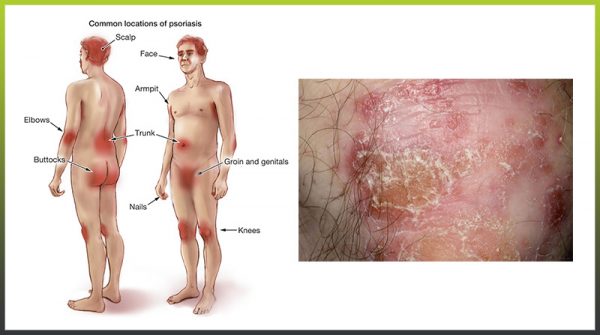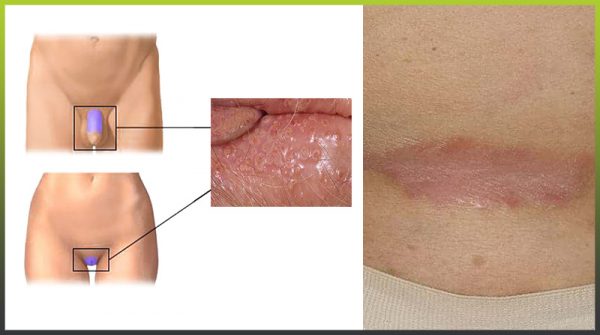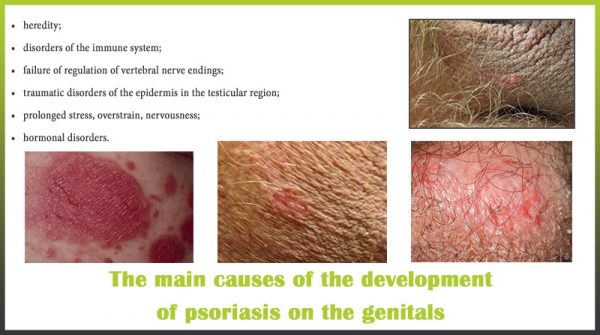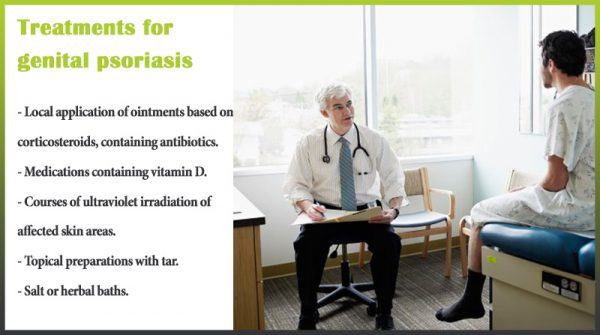Genital psoriasis causes serious discomfort, soreness and very unpleasant sensations. Unfortunately, patients decide to seek help from a doctor when the disease turns into severe form.
Symptoms of genital psoriasis
Genital psoriasis is not a separate disease – it is only the localization of rashes, and in most cases it is not the only one on the body. Rashes may appear in both men and women. In some cases, the disease may take atypical course (the symptoms uncharacteristic for psoriasis). Most often, the atypical form of psoriasis occurs in overweight people.
Symptoms of male genital psoriasis
Most often, this problem concerns 25 – 50 year old men. Much less often it affects patients of younger or older age category. Symptoms in men occur in the form of psoriatic rashes in the groin, pubic and penis. Psoriatic rashes are clearly delimited spots of red color, slightly rising above the surface of the body.
Less often the rash covers the inner part of the foreskin. The disease is accompanied by severe itching, especially in the pubic region and scrotum. Spreading to the groin area, the plaques cover with whitish scales.
With rashes on penis head, patients feel soreness and swelling of the affected areas. The swellings become hot. In some cases, psoriasis on the genitals in men is accompanied by eruptions in the axillary area, the scalp and behind the auricles.
Genital psoriasis in men can have complications in the form of inflammation of the penis (balanitis or balanoposthitis) complicated by phimosis – inability to expose penis head. With progressive phimosis and ineffective therapy, operative treatment might be required – the removal of the foreskin (circumcision).
Symptoms of genital psoriasis in women
Today, genital psoriasis in women is not an uncommon disease. Most often, the initial manifestations of genital psoriasis become noticeable during sudden hormonal fluctuations – it can be a teenage period, pregnancy, menopause. Many women have no idea that this is how psoriasis starts, taking these symptoms for a gynecological disease.
Psoriasis in labia reveals itself in the form of small pink rounded papules. The rashes are covered with specific whitish scales. Similar rashes are formed in the groin and pubic area. Most often, the rash is not accompanied by itching.
In rare cases, women can discover rashes on the mucous tissues in the area of labia minora. In this case, the inflammatory process – often taken for vulvitis – might start (inflammation of the vulva). Genital psoriasis is usually accompanied by eruptions and on other parts of the body. Therefore, doctors do not have any problems with diagnosing the disease.
Symptoms of atypical genital psoriasis
Atypical form of genital psoriasis is characterized by clearly delimited bright red spots of a smooth surface in the area of natural folds. The spots are formed without typical psoriatic scales.
In addition to the genitals, other parts of the body might be affected – this can be the area of the armpits, the area under the breast, the interannual folds. Such areas are constantly exposed to friction which is why people experience itching, burning, irritation. In rare cases, sores and cracks might appear in the area of irritation.
Due to the fact that the atypical form of psoriasis can spread throughout the whole body, some difficulties may arise with the diagnosis. To confirm the diagnosis, a histological examination of a tissue sample taken from the affected skin is required.
The main causes of the development of psoriasis on the genitals
Many people are concerned about the following issue: is genital psoriasis a sexually transmitted disease? Psoriasis on the genitals is a dermatological non-communicable disease and cannot be transmitted sexually.
The main causes have a completely different nature:
- heredity;
- disorders of the immune system;
- failure of regulation of vertebral nerve endings;
- traumatic disorders of the epidermis in the testicular region;
- prolonged stress, overstrain, nervousness;
- hormonal disorders.
It is worth to clarify that if a person has suffered psoriasis before, any damage of the skin in the genital area, any scratch can lead to the reappearance of psoriatic eruptions.
Home remedies for genital psoriasis
The treatment of genital psoriasis, as well the treatment of psoriasis on any other parts of the body, requires an integrated approach. Therapy should be carried out under the strict supervision of a physician. The approximate course of treatment lasts about 5 weeks. Depending on the course of the disease, the doctor can prolong or stop the treatment.
The complex of medical measures is selected individually. Light form of disease might be stopped with the help of topical creams and ointments. Severe forms of psoriasis are treated with systemic oral medications, physiotherapy, sunbathing, etc.
The course of treatment involves the following activities:
- Local application of ointments based on corticosteroids, containing antibiotics. Corticosteroid drugs contribute to the regulation of metabolism, muffle the action of active prostaglandins involved in inflammation.
- Medications containing vitamin D. This vitamin should be taken regularly in order to prevent psoriasis of the joints.
- Courses of ultraviolet irradiation of affected skin areas. The course is usually prescribed according to individual method developed by the doctor.
- Topical preparations with tar. Such medications can cope with inflammation, eliminate discomfort, improving the look of the skin.
- Salt or herbal baths. Baths with sea salt and medicinal baths with the addition of medicinal herbs: soapwort, bidens tripartita, celandine, St. John’s wort, roots of valerian or sage.
When appointing treatment, the doctor takes into account the stage of the disease (progressive, stationary, regressive), the type and development, the age of the patient and the accompanying pathologies. To make therapy effective, patients should adhere to recommendations on diet and skin care.




